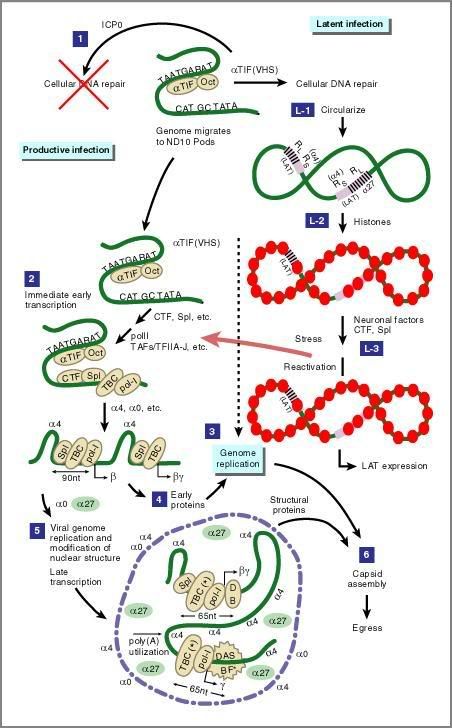
Figure: Pathogenesis of HSV.
Dr. Edward K. Wagner, October 2003: HSV Replication.
- Cellular entry
· Generally, entry of viral into the host cell involves interactions of- * Glycoproteins on the surface of the virus &
* Receptors on the surface of the host cell.· For cellular entry of herpes virus, a glycoprotein embedded in the viral envelope, glycoprotein C binds to the heparan sulfate on the surface of the host cell, provides an initial contacts between viral and host cell.
· A second glycoprotein, glycoprotein D, binds specifically to the herpesvirus entry mediator receptor (HVEM), provides a strong, fixed attachment with the host cell.
· This brings viral and hose cell into closeness, allows other glycoproteins embedded in the viral envelope to interact with other cell surface particle.
· Once bound to the HVEM, glycoprotein D changes its conformation and interacts with viral glycoproteins H and L, which form a complex.
· The interaction of these membrane proteins results in a hemifusion state.
· Glycoproteins B was then interact with this complex, creates a stable entry pore, allows the introduction of viral capsid into the host cell.

Figure: Herpes enters its target cell by membrane fusion.
CST: Urinary Tract Infections and Sexually Transmitted Infections.
- Genetic inoculation
· Once the viral capsid enters the cellular cytoplasm, it is carried to the cell nucleus.
· The viral capsid ejects its DNA contents into the nucleus via capsid portal
· The capsid portal is formed by 12 copies of portal protein, UL6, which arranged as a ring; the proteins contain a leucine zipper sequence of amino acids which allow them to adhere to each other.
· The DNA exits the capsid and goes into the host’s nucleus cell in a single linear segment. - Genome Replication
· Virus genome is accompanied by the a-TIF protein which functions in enhancing immediate-early viral transcription via cellular transcription factors.
· In the nucleus, genome transcription is sequentially regulated in a cascade fashion. Approximately 50 mRNAs are produced by host cell RNA polymerase II.
· Three distinct classes of mRNAs are made:- * immediate early (IE) mRNAs - 5 trans-acting regulators of virus transcription
* Early mRNAs - Further non-structural regulatory proteins & minor structural proteins
* Late mRNAs - Major structural proteins
· The E proteins are used in the regulation of genetic replication of the virus.
· The virion host shutoff protein (VHS or UL41) is very important to viral replication. It shuts off protein synthesis in the host cell, degrades host mRNA, helps in viral replication, and regulates gene expression of viral proteins.
· The late proteins transcribed are used in forming the capsid and the receptors on the surface of the virus.
· Packaging of the viral particles - including the genome, core and the capsid - occurs in the nucleus of the cell.
· Here, concatemers of the viral genome are separated by cleavage and are placed into pre-formed capsids. - Latent infection
· HSV may persist in a quiescent but persistent form known as latent infection
· During latent infection of a cell, HSV express Latency Associated Transcript (LAT) RNA.
· Consequences of LAT production interfere with the following process:- * The metabolism of the host cell is disrupted.
* While the infected cell would ordinarily undergo an organized death or be removed by the immune system.
· During latency, most of the Herpes DNA is inactive, with limited expression of specific virus genes required for the maintenance of latency
· HSV-II establishes latency in sensory nerve ganglia during severe infection and may later periodically reactivate from lumbosacral dorsal root ganglia (DRG) to cause recurrent disease. - Reactivation
· The virus can be reactivated by various disturbances, either
· physical (injury, U.V, hormones, etc)
· or psychological (stress, emotional upset - perhaps affecting immune system/hormonal balance)
· Reactivation of latent virus leads to recurrent disease - virus travels back down sensory nerves to surface of body and replicates,
· consequently result in the appearance of surface sores. - Generally, primary infection occurs through a break in the membrane of genitals or via the secretion of genitals. Initial infection is usually asymptomatic or may be just a minor local vesicular wound. Local multiplication may results, followed by viraemia (viruses enter the bloodstream and hence have access to the rest of the body) and results in systemic infection. There then follows life-long latent infection with periodic reactivation.
- Animation:
Cellular entry (Receptor Binding)
RNA Transcription During Productive Infection
Latency infetion
HSV DNA Replication
1. Wikipedia, 2008: Genital Infection. Internet: http://en.wikipedia.org/wiki/Herpes_simplex#Genital_infection
2. Wikipedia, 2008: Herpes simple virus. Internet: http://en.wikipedia.org/wiki/Herpes_simplex_virus
3. Dr. Wagner, October 2003: Herpes Simplex Virus Research. Internet: http://darwin.bio.uci.edu/~faculty/wagner/hsv4f.html
4. eMedicineHealth, 26 January, 2007: Genital Herpes. Internet: http://www.emedicinehealth.com/genital_herpes/article_em.htm
5. Derek Wong: Pathogenesis of Herpes Simplex Virus Infection. Internet: http://virology-online.com/viruses/HSV2.htm
6. Virusys: HSV information. Internet: http://www.virusys.com/herpes-simplex-virus-type-1-(hsv%111)/hsv%111-information/hsv-information/
Comments and inquiries are always welcome.
Prepared by Tai Chu Cheng 1061107241

No comments:
Post a Comment